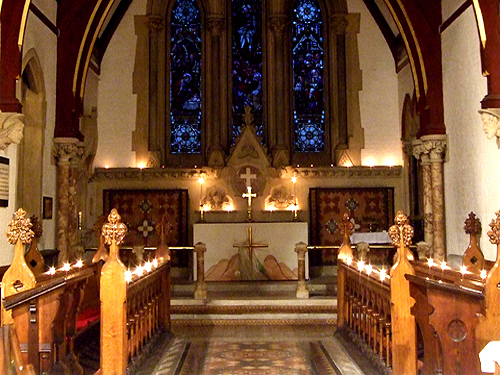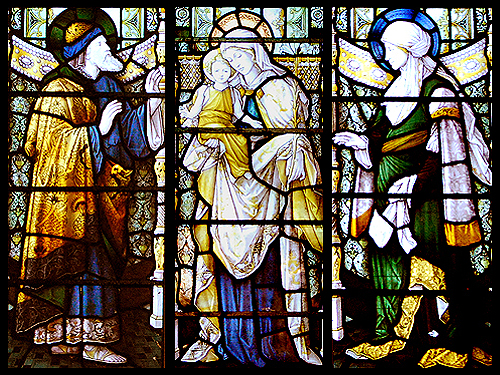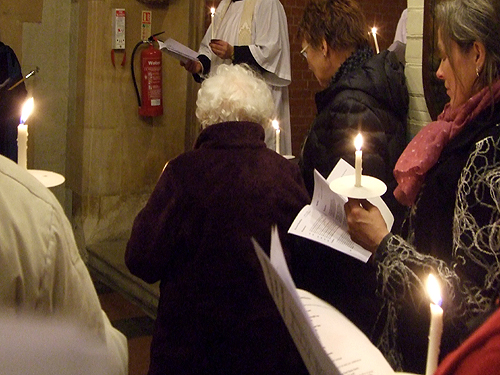
Pages in this section: Church Year | Advent | Christmas | Epiphany | Candlemas | Lent | Ash Wednesday | Mothering Sunday | Palm Sunday | Maundy Thursday | Good Friday | Holy Saturday | Easter | Ascension Day | Pentecost | Trinity Sunday | St James's Day | Harvest Festival | All Saints' Day & All Souls' Day | Remembrance Sunday
Candlemas occurs forty days after Christmas (on February 2nd) and is the end of the Christmas season. In the Christian year it is celebrated on the Sunday closest to this date. The Church Colour for Candlemas is white (or gold).
What happens at St James's
At St James's we have celebrated Candlemas with different services, for example All Age Services at 11am and festival 9.30am Parish Communion services.
Background
In New Testament times, forty days old was an important age for a baby boy. It was when he made his first ‘public appearance’ according to the Jewish law at that time. St Luke's gospel tells us that Mary and Joseph took the baby Jesus and presented him in the Temple in Jerusalem forty days after his birth. The family met Simeon and Anna, who had dedicated their lives to God. Simeon declared: "my eyes have seen your salvation ... a light to lighten the Gentiles, and the glory of your people Israel". St James's west baptistry windows depict this scene of Jesus being presented in the Temple. The centre window has the infant Jesus being carried by his mother, Mary. The left window below has Simeon, the devout old man who acclaims Jesus as light and glory. The right window below has a similarly devout person, Anna, who likewise greets Jesus.
Early Christians developed the tradition of lighting many candles to celebrate this day and this custom is still followed today by many congregations. The Church also developed the custom of blessing the year’s supply of candles for the church on this day - both reasons for the name Candlemas (mas means Mass or Holy Communion). Candles were important in those days not only because there was no electric light but also because some people thought they gave protection against plague, illness and famine. For Christians they were, and still are, a reminder of something even more important. Before Jesus came to earth, it was as if everyone was 'in the dark'. People often felt lost, lonely and with no one to help them. Then Jesus came with his message of help and comfort, a guiding light to them in the darkness. Christians often talk of Jesus as 'the light of the World' and candles are lit during church services to remind Christians of this.
Candlemas is also a turning point in the Christian year. As well as closing the Christmas season, there is a darker side to this episode which directs our thoughts towards Christ's Passion. Mary was the first to hear the good news; she nurtures the Christ-child; she ponders the sayings of shepherds and wise men. Then Simeon tells her that "a sword will pierce your own soul too". His words are a poignant indicator of the suffering that Christ will endure, his crucifixion and Mary's own future pain and anguish. In the north aisle is a window depicting Mary as the 'Mater Dolorosa' or 'Mother of Sorrows'. Mary's pose and her dark clothing represent her mourning her son.
When Mary and Joseph went to the Temple, Mary, as a new mother, was purified (made clean). This goes back to a Jewish tradition that women were considered unclean after the birth of a child and were not permitted to enter the Temple to worship for forty days after the birth of a son or sixty days after the birth of a daughter. At the end of this period, the mother was brought to the Temple or synagogue and ritually purified. After this she was able go to religious services again and generally go out in public. The Festival of the Presentation of Christ in the Temple (Candlemas) also celebrates the ritual Purification of the Virgin Mary.
 |
 |
 |